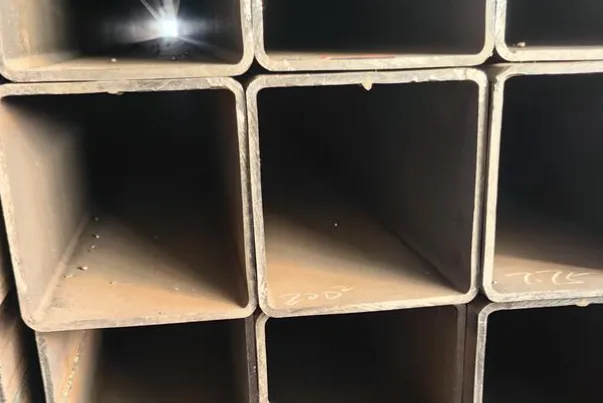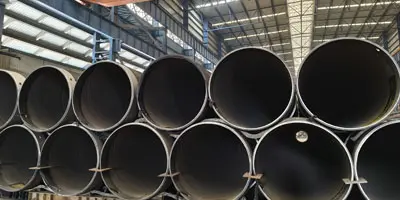Square Tube Meaning
As the name implies, a square tube is a steel tube with a square cross-section. It is a hollow, light, thin-walled steel tube, commonly known as a cold-bent steel profile. Square tubes are typically made from Q235
hot-rolled or cold-rolled strip or coil as the base material. These materials are then subjected to cold bending, followed by high-frequency welding to form the square cross-section.
The strength characteristics of square tubes play a crucial role in determining their suitability for various applications. Understanding these characteristics is essential when selecting the right material and designing square tubes for specific structural purposes. This article delves into key strength calculations and practical applications based on the actual material properties of square tubes.
Strength Calculation of Square Tubes
Calculation Method
When a square tube is subjected to bending, deformation occurs, affecting its structural strength. The basic formula for calculating the bending strength of a square tube is:
M=4W⋅C
M: Bending moment
W: Applied load
C: Coefficient related to the tube’s shape and cross-sectional form
This calculation is essential to avoid tube deformation under significant loads. The greater the bending moment, the higher the likelihood that the tube will deform or fail.
Practical Example
For a square tube made of 100 mm wide steel with a wall thickness of 5 mm, the bending strength will depend on the material properties, such as the bending stress (approximately 345 MPa for ASTM A500 steel).
Calculation of Square Tube Load-Bearing Capacity
Calculation Method
The load-bearing capacity of a square tube under vertical load is calculated using the following formula:
P=F⋅S
P: Load-bearing capacity
F: Applied force
S: Cross-sectional area
Important Factors
Material Properties: The mechanical properties of steel, such as tensile strength (375 MPa for Q235) and yield strength (235 MPa for Q235), are essential for calculating load-bearing capacity.
Square Tube Size: A larger cross-sectional area generally improves the load-bearing capacity. This calculation depends on the specific area of the cross-section.
Weld Size: Welds in square tubes play a critical role in their load-bearing capacity. The properties of the weld are determined through specific testing and directly affect structural strength.
Weld Strength: The weld strength depends on the materials used and the welding process. If welding standards are not met, the load-bearing capacity of the square tube may be compromised.

Precautions:
1. The calculation of square pipe welding load-bearing involves multiple elements and requires comprehensive calculation based on specific circumstances.
2. It is necessary to select an appropriate heat treatment plan according to the design requirements to ensure that the mechanical properties of the square tube meet the requirements.
3. In actual engineering applications, welding should be carried out in strict accordance with the requirements of welding standards to ensure welding quality.
4. During design and construction, the type and direction of load endured by the square pipe should be considered in order to select the appropriate square pipe size and welding method.
5. When calculating the load-bearing capacity of square pipes, the margin of the material needs to be taken into account in order to reserve a certain safety factor.
How is the bending strength of a square tube calculated?
The bending strength of a square tube is calculated using the formula:
M=4W⋅C
Where M is the bending moment, W is the applied load, and C is a coefficient related to the tube's geometry.
Formula for calculating the bearing capacity of square tubes
For example, a 50*30*1.5 square tube is erected at two ends, with a span of 1 meter suspended in the middle. How many items can be placed on this 1-meter span of 50*30*1.5 square tubes?
M=Pac/L(M: bending moment, P concentrated force, a concentrated force distance from the support, c concentrated force distance from another support, L span, L=a+c)
W=b*h*h*h/12(only for rectangular sections)
f=M/W≤allowable stress of the material (elastic tensile strength/safety factor).
Strength calculation=M/W (where bending moment M=0.125qL*2, W is section modulus)
Stiffness calculation=(5qL*4)/384EI
How to calculate the vertical bearing capacity of square tubes and galvanized square tubes?
1. Calculate the compressive stress, which is the compressive stress generated by the vertical pressure acting on the cross section of the square tube. It is the pressure (unit N) divided by the cross-sectional area of the square tube (unit m square). As long as the compressive stress is less than the allowable stress of the material.
2. The square tube is under pressure, and the stability must be calculated. The calculation of stability is more complicated. It depends on whether the connection method is fixed at both ends or fixed at one end and hinged at the other end. It is estimated that you will use more than one column, so you can simply calculate it as fixed at both ends. Simple calculation of critical pressure: P=(4*n*Pi^2*E*I)/[(L/2)^2]. n is the number of columns, pi^2 is the square of the beat, E is the elastic modulus, I is the moment of inertia, and L is the length of the column.
The above calculations are simple calculations, and the safety factor and even seismic load must also be considered. Please ask experienced professional engineers to calculate the specific situation analysis. The above information is for reference only.
Conclusion
Square tubes, made from materials like
ASTM A500 steel or stainless steel, are essential in various applications. Their ability to resist bending, torsion, and axial loads makes them an ideal choice for structural engineering, industrial machinery, and architectural design. Understanding the strength calculations for these tubes allows for the proper selection of materials and ensures structural integrity in every application.






 English
English Español
Español بالعربية
بالعربية











 Phone :
Phone :  Whatsapp :
Whatsapp :  Email :
Email : 


